Bayesian Entropy Methodology: A Novel Approach to Setting Anti-Islanding Protections with Enhanced Stability and Sensibility
Abstract
1. Introduction
1.1. Background and Motivation
1.2. Literature Review of Islanding Detection Methods
1.3. Contributios of Bayesian Entropy Methodology
- Modeling the protection uncertainty: The entropy model is not only an objective function; entropy also is the model of the uncertainty of the protection system. This allows for the search of optimal settings but furthermore, this also enables the comparison of different IDMs in terms of their minimum achievable entropy.
- Abstracting the signal and its dynamics involved in island detection: By defining a statistical experiment, BEM simply counts successes or failures. This allows treating the protection system as a ‘black box’ and identifying which setting minimizes entropy. It also makes the methodology independent of the time duration of each of the cases used, not needing them to be equal in the time framework.
- Reduction of the computational burden: This is possible thanks to the employed Bayesian inference, which is computationally efficient compared to frequentist alternatives, reducing the size of datasets.
- Ability to measure the experiment’s uncertainty: BEM not only allows for the protection uncertainty but also enables the measurement of the uncertainty of the defined statistical experiment. This feature clearly determines the number of cases needed for evaluation in search of the optimal adjustment for the protection.
2. Entropy Mathematic Model of Anti-Islanding Protection
Ideal Anti-Islanding Protection Model
3. Bayesian Methodology for Forward Success Probability Calculation
3.1. Definition of the Statistical Experiment for Probabilities Estimation
- There are an infinite quantity of possible cases of islanding and events of no islanding. A random sample of cases is taken with a uniform probability distribution, and the sample size is and cases, respectively.
- The experiment will consist of testing the protection performance for each case with a particular fixed setting for time delay () and pickup ). Each case will be considered a one-off trial, like throwing a dice, resulting in success or failure. The probability of success will remain constant from one trial to another, as the parameters of the protection setting will not be modified after each trial.
- The experiment will be conducted in two distinct populations: firstly, for the subset of islanding formation cases, and secondly, for the subset of events of no islanding cases, ensuring independence. For the set of islanding events, the population probability of success will be the probability . In the same way, for the set of events of no islanding cases, the population probability of success will be the probability .
- Based on the previous considerations, the probability of achieving ‘x’ successes for specific anti-islanding protection with a success population probability on a sample of and island events can be calculated as follows:
3.2. Bayesian Inference for Forward Success Probabilities
3.3. Entropy of the Experiment
4. Power System and Datasets of Events
4.1. Test System
4.2. Islanding Samples Dataset
4.3. Disturbances Samples Dataset (Events of No Islanding)
4.4. Minimum Achievable Entropy for the Defined Datasets
5. Results
5.1. Entropy Surface Exploration, Minimal Entropy Settings and Validation Instances
5.2. Sensitivity Analysis: Islanding Datasets Comparison
5.3. Stability against Tranmission System Disturbances Analysis
6. Discussion
7. Conclusions
- Innovative uncertainty modeling: The use of entropy as a model for protection uncertainty has proved to be a significant advancement. It not only serves as an objective function but also provides a comparative measure for different IDMs based on their minimum achievable entropy.
- Computational efficiency: The employment of Bayesian inference in BEM has considerably reduced computational burdens. This efficiency is evident in the reduced size of datasets required compared to other methods, significantly, ranging between 91% and 98%.
- Signal abstraction: The process of abstracting the signal and its dynamics in island detection involves treating the protection system as a ‘black box’, defining a statistical experiment, and simply counting successes and failures when evaluating a protection system. This level of abstraction has facilitated the computation of minimal settings by comparing islanding cases lasting 2.5 s with disturbances of 10.5 s duration.
- Precise dataset sizing: A novel aspect of BEM is its ability to measure the uncertainty of the statistical experiment itself, allowing for an accurate sizing of the datasets based on success probabilities using the concept of entropy. It has been verified that defining the dataset size with a total of 60 cases enables the achievement of a minimum entropy value of H = 0.34602. This is associated with forward success probabilities ranging between unity and 0.9891. These findings have been appropriately confirmed through validation instances.
Author Contributions
Funding
Data Availability Statement
Acknowledgments
Conflicts of Interest
Nomenclature
| BEM | Bayesian entropy methodology |
| DERs | distributed energy resources |
| EPS | electric power system |
| LFDD | low-frequency demand disconnection |
| IDMs | islanding detection methods |
| DG | distributed generator |
| PLC | power line communication |
| PCC | point of common coupling |
| THD | total harmonic distortion |
| FVT | frequency and voltage threshold |
| ANSI | American National Standards Institute |
| VVS | voltage vector shift |
| ASMM | automatic setting map methodology |
| RoCoF | rate of change of frequency |
| AVR | automatic voltage regulator |
| PSS | power system stabilizer |
| EMT | electromagnetic transient |
| DPL | Digsilent Programming Language |
| ER G83 | Engineering Recommendation G83 |
| NDZ | non-detection zone |
Appendix A
| Line | Type | Length | ||
|---|---|---|---|---|
| A-B | OHL-Δ | 90 Km | 0.2533 Ω/Km | 0.436 Ω/Km |
| B-C | OHL-Δ | 220 Km | 0.2533 Ω/Km | 0.436 Ω/Km |
| A-C (1) | OHL-Δ | 1 Km | 0.2533 Ω/Km | 0.436 Ω/Km |
| A-C (2) | OHL-Δ | 1 Km | 0.2533 Ω/Km | 0.436 Ω/Km |
| Generator | [MVA] | Voltage [kV] | Connection | [s] |
|---|---|---|---|---|
| G1 (Ref.) | 210 | 15.75 | YN | 7.34 |
| G2 | 46.55 | 10.5 | YN | 6.92 |
| G3 | 210 | 15.75 | YN | 7.34 |
| G4 | 46.55 | 10.5 | YN | 6.92 |
| Line | Type | Length | ||
|---|---|---|---|---|
| B0-B1 | Cable-Δ | 2 Km | 0.1281 Ω/Km | 0.09424 Ω/Km |
| B1-B2 | Cable-Δ | 3 Km | 0.1281 Ω/Km | 0.09424 Ω/Km |
| B2-B3 | Cable-Δ | 5 Km | 0.1281 Ω/Km | 0.09424 Ω/Km |
| B3-B4 | Cable-Δ | 2 Km | 0.1281 Ω/Km | 0.09424 Ω/Km |
| Line | Type | Length | ||
|---|---|---|---|---|
| B1-B5 | Cable-Δ | 10 Km | 0.1281 Ω/Km | 0.09424 Ω/Km |
| B5-B6 | Cable-Δ | 2 Km | 0.1281 Ω/Km | 0.09424 Ω/Km |
| B6-B7 | Cable-Δ | 10 Km | 0.1281 Ω/Km | 0.09424 Ω/Km |
| B7-B8 | Cable-Δ | 8 Km | 0.1281 Ω/Km | 0.09424 Ω/Km |
| B8-B9 | Cable-Δ | 12 Km | 0.1281 Ω/Km | 0.09424 Ω/Km |
| DER | [MVA] | Voltage [kV] | Connection | |
|---|---|---|---|---|
| DG1 | 0.2 | 0.22 | YN | 4 |
| DG2 | 0.5 | 0.22 | YN | 0 |
References
- Caballero-Peña, J.; Cadena-Zarate, C.; Parrado-Duque, A.; Osma-Pinto, G. Distributed Energy Resources on Distribution Networks: A Systematic Review of Modelling, Simulation, Metrics, and Impacts. Int. J. Electr. Power Energy Syst. 2022, 138, 107900. [Google Scholar] [CrossRef]
- Agwa, A.M.; El-Fergany, A.A. Protective Relaying Coordination in Power Systems Comprising Renewable Sources: Challenges and Future Insights. Sustainability 2023, 15, 7279. [Google Scholar] [CrossRef]
- Laaksonen, H.; Hovila, P. Islanding Detection During Intended Island Operation of Nested Microgrid. In Proceedings of the 2018 IEEE PES Innovative Smart Grid Technologies Conference Europe (ISGT-Europe), Sarajevo, Bosnia and Herzegovina, 21–25 October 2018; pp. 1–6. [Google Scholar]
- Escobar-Orozco, L.F.; Gómez-Luna, E.; Marlés-Sáenz, E. Identification and Analysis of Technical Impacts in the Electric Power System Due to the Integration of Microgrids. Energies 2023, 16, 6412. [Google Scholar] [CrossRef]
- Conti, S. Analysis of Distribution Network Protection Issues in Presence of Dispersed Generation. Electr. Power Syst. Res. 2009, 79, 49–56. [Google Scholar] [CrossRef]
- Stevens, J.; Bonn, R.; Gin, J.; Gonzalez, S.; Kern, G. Development and Testing of an Approach to Anti-Islanding in Utility-Interconnected Photovoltaic Systems; Sandia National Laboratories: Albuquereque, NM, USA, 2000. [Google Scholar]
- Kou, G.; Deverick, J.; Phelps, K.; Nguyen, T.; Velez-Cedeno, F.G. Impact of Distributed Energy Resources on Arc Flash Incident Energy. IEEE Trans. Power Deliv. 2020, 35, 531–539. [Google Scholar] [CrossRef]
- IEEE 1547-2018; IEEE Standard for Interconnection and Interoperability of Distributed Energy Resources with Associated Electric Power Systems Interfaces (Revision of IEEE Std 1547-2003). IEEE: Piscataway, NJ, USA, 2018; 138p. [CrossRef]
- Chowdhury, S.P.; Chowdhury, S.; Crossley, P.A. UK Scenario of Islanded Operation of Active Distribution Networks with Renewable Distributed Generators. Int. J. Electr. Power Energy Syst. 2011, 33, 1251–1255. [Google Scholar] [CrossRef]
- Energy Networks Association. The Distribution Code of Licencsed Distribution Network Operators of Great Britain; Energy Networks Association: London, UK, 2023. [Google Scholar]
- European Commission. Commission Regulation (EU) 2016/631 of 14 April 2016 Establishing a Network Code on Requirements for Grid Connection of Generators. Off. J. Eur. Union 2016, L112, 1–68. [Google Scholar]
- Lukac, M.; Matišic, Z. Anti-Islanding Protection of Distributed Generators with Regard to Sensitivity in a Balance and Power System Stability. CIRED Open Access Proc. J. 2017, 2017, 943–946. [Google Scholar] [CrossRef]
- Dyśko, A.; Booth, C.; Anaya-Lara, O.; Burt, G.M. Reducing Unnecessary Disconnection of Renewable Generation from the Power System. IET Renew. Power Gener. 2007, 1, 41–48. [Google Scholar] [CrossRef]
- Barkat, F.; Cheknane, A.; Guerrero, J.M.; Lashab, A.; Istrate, M.; Gavrilas, M.; Motas, J.G.; Banu, I.V. Review, Analysis, and Performance Evaluation of the Most Common Four Active Methods for Islanding Detection in Grid-Connected Photovoltaic Systems. Electr. Power Syst. Res. 2023, 214, 108909. [Google Scholar] [CrossRef]
- Alam, M.R.; Begum, M.T.A.; Muttaqi, K.M. Assessing the Performance of ROCOF Relay for Anti-Islanding Protection of Distributed Generation under Subcritical Region of Power Imbalance. IEEE Trans. Ind. Appl. 2019, 55, 5395–5405. [Google Scholar] [CrossRef]
- Dyśko, A.; Booth, C.; Burt, A.G.; Yip, H.T. Testing Methodology for LOM Protection Performance Assessment. In Proceedings of the 10th IET International Conference on Developments in Power System Protection (DPSP 2010): Managing the Change, Manchester, UK, 29 March–1 April 2010. [Google Scholar]
- National Grid ESO. Operating a Low Inertia System, a System Operability Framework Document; National Grid Electricity System Operator Limited: London, UK, 2020. [Google Scholar]
- National Grid ESO. Technical Report on the Events of 9 August 2019; National Grid Electricity System Operator Limited: London, UK, 2019; pp. 2–38. [Google Scholar]
- Ofgem. Interim Report into the Low Frequency Demand Disconnection (LFDD) Following Generator Trips and Frequency Excursion on 9 Aug 2019; Ofgem: London, UK, 2019; pp. 1–26. [Google Scholar]
- MacIver, C.; Bell, K.; Nedd, M. An Analysis of the August 9th 2019 GB Transmission System Frequency Incident. Electr. Power Syst. Res. 2021, 199, 107444. [Google Scholar] [CrossRef]
- ENA. Accelerated Loss of Mains Change Programme; Energy Networks Association: London, UK, 2019; p. 1. [Google Scholar]
- Mourinho, F.A.; Assis, T.M.L. A New Approach to Retrofit Plans for Distributed Energy Resources to Mitigate Adverse Impacts on Bulk Power Systems Stability. IEEE Lat. Am. Trans. 2022, 20, 669–676. [Google Scholar] [CrossRef]
- Friedemann, D.F.; Motter, D. Vector Surge Estimation Methods for Loss of Mains Protection and an Equivalence Relation with Frequency Estimation for System Disturbances. Electr. Power Syst. Res. 2023, 223, 109555. [Google Scholar] [CrossRef]
- NERC. Lesson Learned: Single Phase Fault Precipitates Loss of Generation and Load; North American Electric Reliability Corporation: Atlanta, GA, USA, 2020; pp. 1–8. [Google Scholar]
- Mishra, M.; Chandak, S.; Rout, P.K. Taxonomy of Islanding Detection Techniques for Distributed Generation in Microgrid. Renew. Energy Focus 2019, 31, 9–30. [Google Scholar] [CrossRef]
- Abu Sarhan, M. An Extensive Review and Analysis of Islanding Detection Techniques in DG Systems Connected to Power Grids. Energies 2023, 16, 3678. [Google Scholar] [CrossRef]
- Poluektov, A.; Pinomaa, A.; Romanenko, A.; Ahola, J.; Kosonen, A. Sensitivity Analysis of a PLC-Based DSSS Anti-Islanding System in Power Distribution Grids. Int. J. Electr. Power Energy Syst. 2019, 113, 739–747. [Google Scholar] [CrossRef]
- Etxegarai, A.; Eguía, P.; Zamora, I. Analysis of Remote Islanding Detection Methods for Distributed Resources. Renew. Energy Power Qual. J. 2011, 1, 1142–1147. [Google Scholar] [CrossRef]
- Reddy, C.R.; Goud, B.S.; Reddy, B.N.; Pratyusha, M.; Vijay Kumar, C.V.; Rekha, R. Review of Islanding Detection Parameters in Smart Grids. In Proceedings of the 8th International Conference on Smart Grid (icSmartGrid), Paris, France, 17–19 June 2020; pp. 78–89. [Google Scholar]
- Zhang, S.; Wang, L.; Du, X.; Zhang, R.; Huang, Z.; Duan, S.; Yang, W.; Wang, P.; Zhang, J. Improved Active Islanding Detection Technique with Different Current Injection Waveform. Processes 2023, 11, 1838. [Google Scholar] [CrossRef]
- Abo-Khalil, A.G.; Eltamaly, A.M.; Alharbi, W.; Al-Qawasmi, A.; Alobaid, M.; Alarifi, I.M. A Modified Active Frequency Islanding Detection Method Based on Load Frequency and Chopping Fraction Changes. Int. Trans. Electr. Energy Syst. 2021, 31, e13033. [Google Scholar] [CrossRef]
- Boubaris, A.; Kyritsis, A.; Babouras, K.; Frantzeskakis, S.; Papanikolaou, N.; Papadopoulos, T.; Vidaurrazaga, I.; Alonso, R. Study on the Effectiveness of Commercial Anti-Islanding Algorithms in the Prospect of Mass Penetration of PVs in Low-Voltage Distribution Networks. IET Energy Syst. Integr. 2021, 3, 39–59. [Google Scholar] [CrossRef]
- Kulkarni, N.K.; Khedkar, M.; Bhende, C.N.; Singh, S.K. Prioritization of Passive Parameters from Modified Averaging Approach-Based Computation (MAAC) Methodology for Ascertaining Formation of Single and Multi-Location Unintentional Islands. Energies 2022, 15, 6441. [Google Scholar] [CrossRef]
- Salles, D.; Freitas, W.; Vieira, J.C.M.; Venkatesh, B. A Practical Method for Nondetection Zone Estimation of Passive Anti-Islanding Schemes Applied to Synchronous Distributed Generators. IEEE Trans. Power Deliv. 2015, 30, 2066–2076. [Google Scholar] [CrossRef]
- Arguence, O.; Cadoux, F.; Raison, B.; De Alvaro, L. Non-Detection Zone of an Anti-Islanding Protection with Rate of Change of Frequency Threshold. CIRED Open Access Proc. J. 2017, 2017, 1338–1341. [Google Scholar] [CrossRef]
- Vieira, J.C.M.; Freitas, W.; Huang, Z.; Xu, W.; Morelato, A. Formulas for Predicting the Dynamic Performance of ROCOF Relays for Embedded Generation Applications. IEE Proc. Gener. Transm. Distrib. 2006, 153, 399. [Google Scholar] [CrossRef]
- Patsidis, A.; Tzelepis, D.; Dyśko, A.; Booth, C. Investigation of the Performance of ROCOF-Based Lom Protection in Distribution Networks with Virtual Synchronous Generators. In Proceedings of the 15th International Conference on Developments in Power System Protection (DPSP 2020), Liverpool, UK, 9–12 March 2020; Institution of Engineering and Technology: London, UK, 2020. 6p. [Google Scholar]
- Dysko, A.; Tzelepis, D.; Booth, C. Assessment of Risks Resulting from the Adjustment of Vector Shift (VS) Based Loss of Mains Protection Settings; University of Strathclyde: Glasgow, UK, 2017. [Google Scholar]
- Western-Power-Distribution Loss of Mains Protection—Distribution System Operability Framework June 2018. 2018, pp. 1–10. Available online: https://www.nationalgrid.co.uk/dso/dsof (accessed on 18 December 2023).
- Raza, S.; Mokhlis, H.; Arof, H.; Laghari, J.A.; Wang, L. Application of Signal Processing Techniques for Islanding Detection of Distributed Generation in Distribution Network: A Review. Energy Convers. Manag. 2015, 96, 613–624. [Google Scholar] [CrossRef]
- Lidula, N.W.A.; Rajapakse, A.D. A Pattern-Recognition Approach for Detecting Power Islands Using Transient Signals-Part II: Performance Evaluation. IEEE Trans. Power Deliv. 2012, 27, 1071–1080. [Google Scholar] [CrossRef]
- Allan, O.A.; Morsi, W.G. A New Passive Islanding Detection Approach Using Wavelets and Deep Learning for Grid-Connected Photovoltaic Systems. Electr. Power Syst. Res. 2021, 199, 107437. [Google Scholar] [CrossRef]
- Chaitanya, B.K.; Yadav, A.; Pazoki, M. Reliable Islanding Detection Scheme for Distributed Generation Based on Pattern-Recognition. IEEE Trans. Ind. Inform. 2021, 17, 5230–5238. [Google Scholar] [CrossRef]
- Kulkarni, N.K.; Khedkar, M.K. Methods to Detect the Occurrence of an Unintentional Island with Passive Approach: A Review. J. Inst. Eng. Ser. B 2021, 102, 1091–1111. [Google Scholar] [CrossRef]
- Banu, I.V.; Barkat, F.; Istrate, M.; Guerrero, J.M.; Culea, G.; Livinti, P.; Motas, J.G.; Neagu, B.; Andrioaia, D. Passive Anti-Islanding Protection for Three-Phase Grid-Connected Photovoltaic Power Systems. Int. J. Electr. Power Energy Syst. 2023, 148, 108946. [Google Scholar] [CrossRef]
- Raipala, O.; Mäkinen, A.; Repo, S.; Järventausta, P. The Effect of Different Control Modes and Mixed Types of DG on the Non-Detection Zones of Islanding Detection. In Proceedings of the CIRED 2012 Workshop: Integration of Renewables into the Distribution Grid, Lisbon, Portugal, 29–30 May 2012; p. 237. [Google Scholar]
- Motter, D.; De Melo Vieira, J.C. The Setting Map Methodology for Adjusting the DG Anti-Islanding Protection Considering Multiple Events. IEEE Trans. Power Deliv. 2018, 33, 2755–2764. [Google Scholar] [CrossRef]
- Motter, D.; Vieira, J.C.M. Improving the Islanding Detection Performance of Passive Protection by Using the Undervoltage Block Function. Electr. Power Syst. Res. 2020, 184, 106293. [Google Scholar] [CrossRef]
- Arefin, A.A.; Hasan, K.N.B.M.; Othman, M.L.; Romlie, M.F.; Saad, N.; Nor, N.B.M.; Abdullah, M.F. A Novel Island Detection Threshold Setting Using Phasor Measurement Unit Voltage Angle in a Distribution Network. Energies 2021, 14, 4877. [Google Scholar] [CrossRef]
- Arefin, A.A.; Rahman, M.S.; Hossain Lipu, M.S.; Sarker, M.R.; Sawaran Singh, N.S.; Meraj, S.T. Determining Unintentional Island Threshold to Enhance the Reliability in an Electrical Distribution Grid. Mathematics 2023, 11, 886. [Google Scholar] [CrossRef]
- Andrade Mourinho, F.; Mariano Lessa Assis, T. Impact of Cascade Disconnection of Distributed Energy Resources on Bulk Power System Stability: Modeling and Mitigation Requirements. J. Mod. Power Syst. Clean Energy 2023, 11, 412–420. [Google Scholar] [CrossRef]
- Shannon, C.E. A Mathematical Theory of Communication. Bell Syst. Tech. J. 1948, 27, 379–423. [Google Scholar] [CrossRef]
- Walpole, R.E.; Myers, R.H.; Sharon, M.L.; Keying, Y. Probability & Statistics for Engineers & Scientists, 9th ed.; Pearson Education Limited: London, UK, 2016; Volume 1, ISBN 9780321629111. [Google Scholar]
- Insua, D.R.; Ruggeri, F.; Soyer, R.; Wilson, S. Advances in Bayesian Decision Making in Reliability. Eur. J. Oper. Res. 2020, 282, 1–18. [Google Scholar] [CrossRef]
- Energy Networks Association. Engineering Recommendation G83 Issue 2 Recommendations for the Connection of Type Tested Small-Scale Embedded Generators (Up to 16A per Phase) in Parallel with Low-Voltage Distribution Systems; Energy Networks Association: London, UK, 2019. [Google Scholar]
- Affonso, C.M.; Freitas, W.; Xu, W.; da Silva, L.C.P. Performance of ROCOF Relays for Embedded Generation Applications. IEE Proc. Gener. Transm. Distrib. 2005, 152, 109–114. [Google Scholar] [CrossRef]
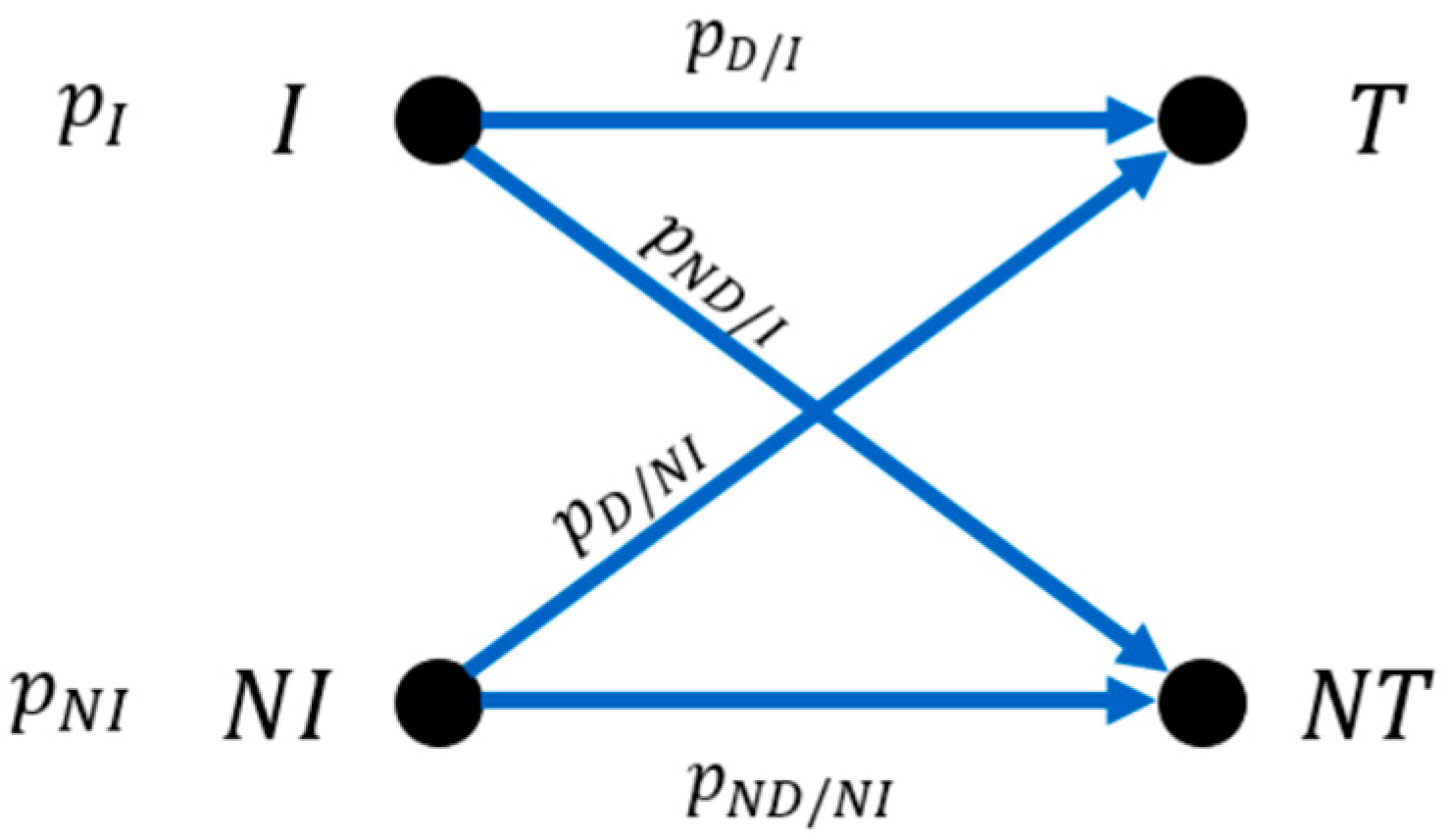




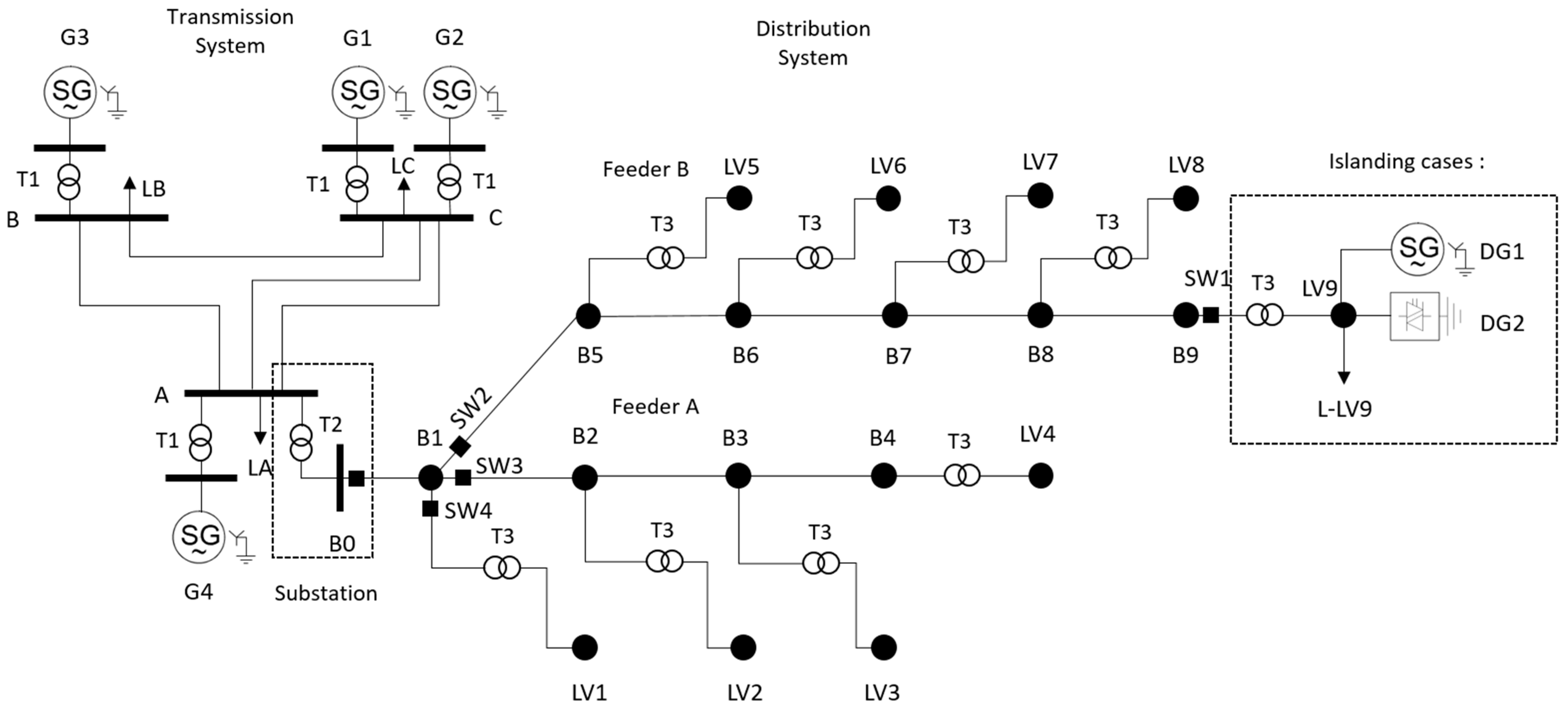


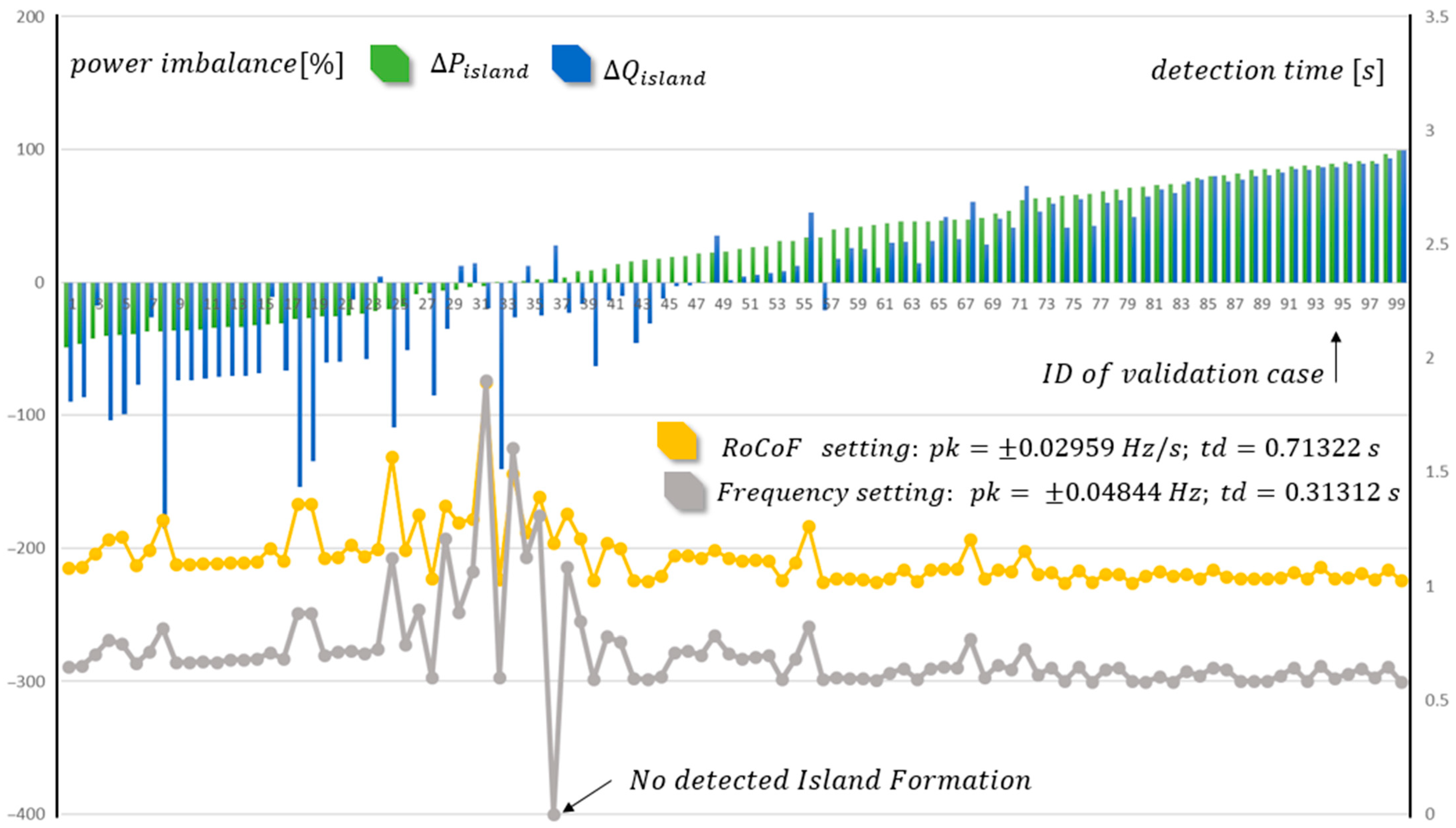


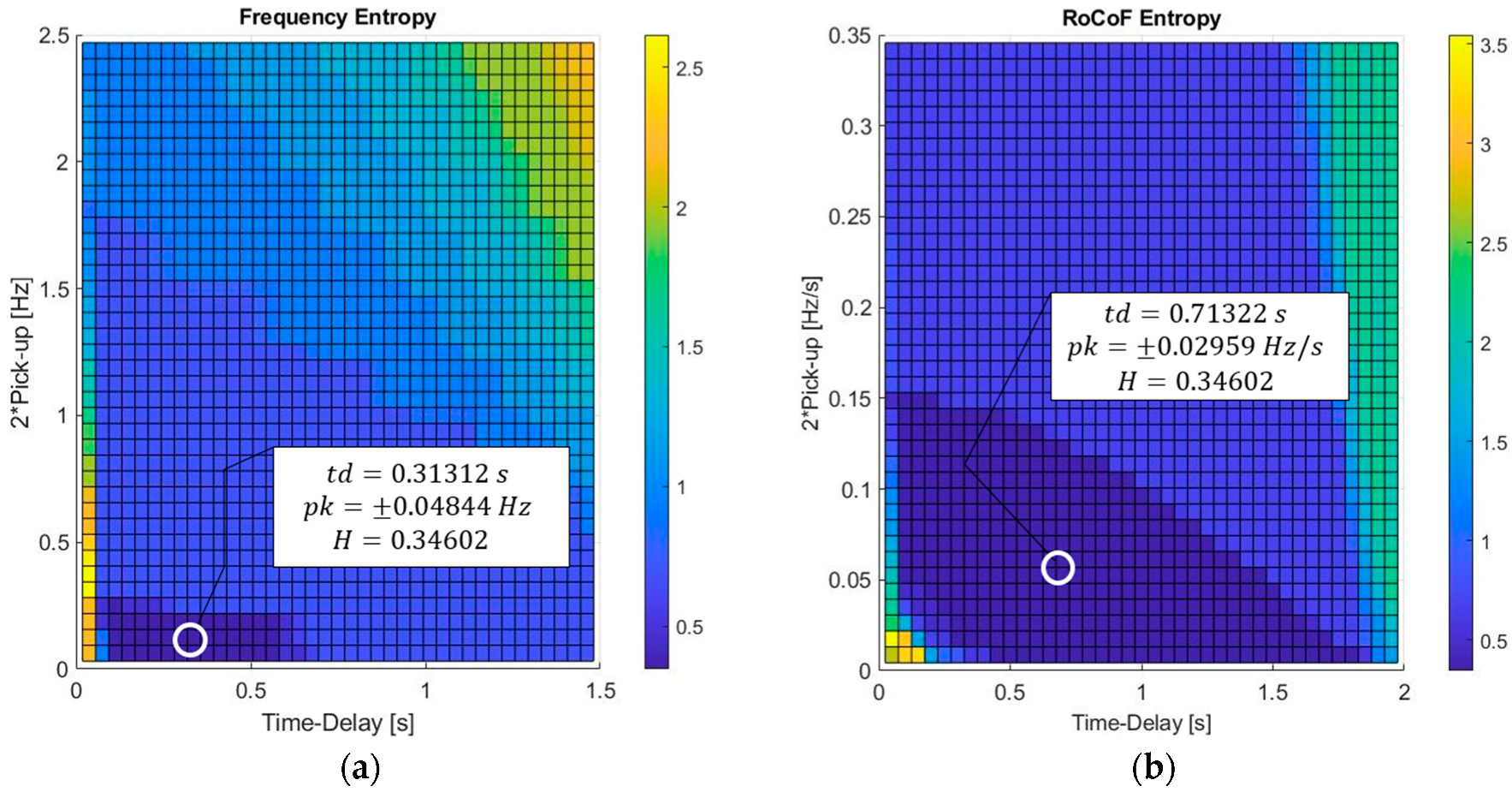
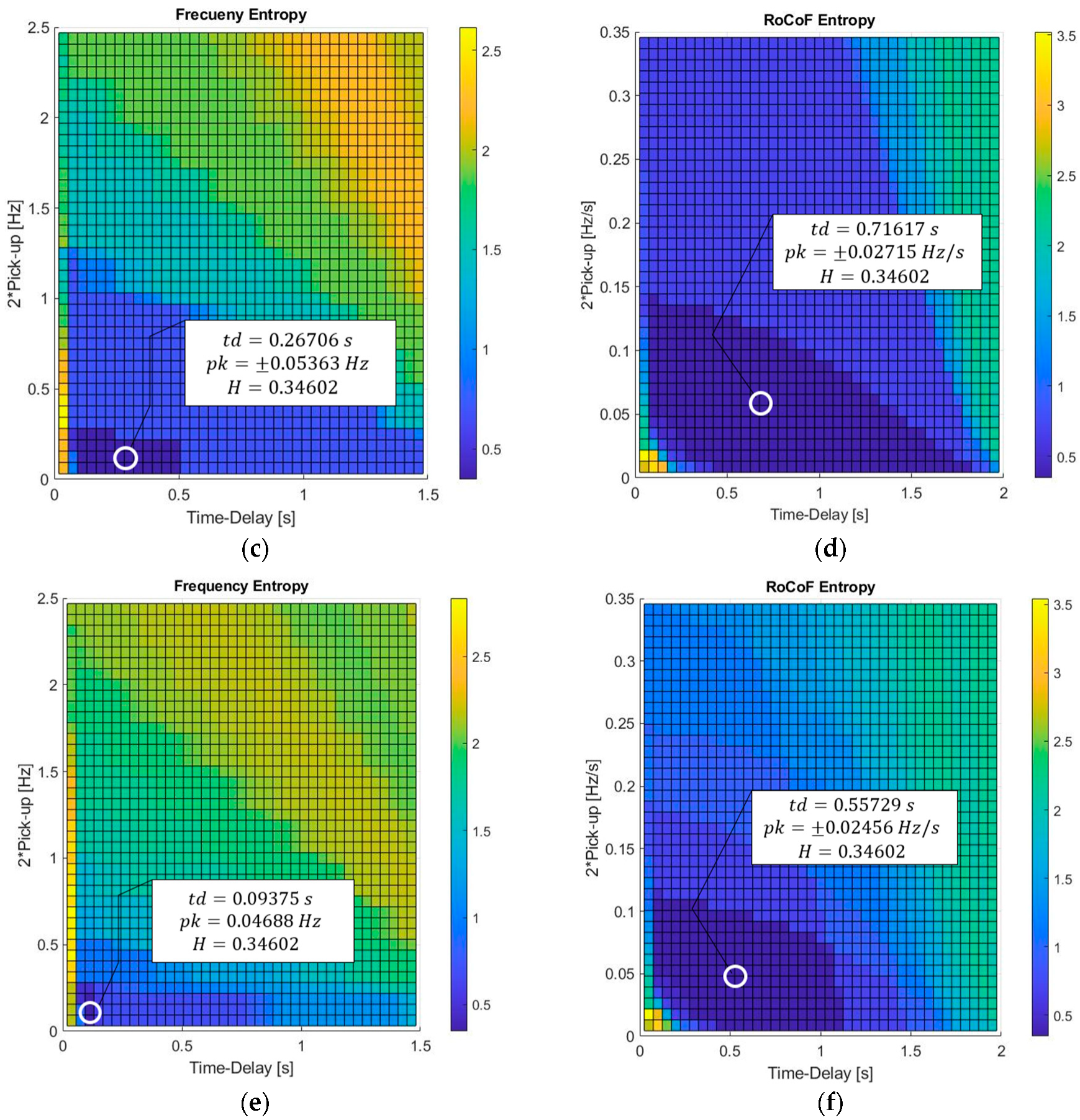

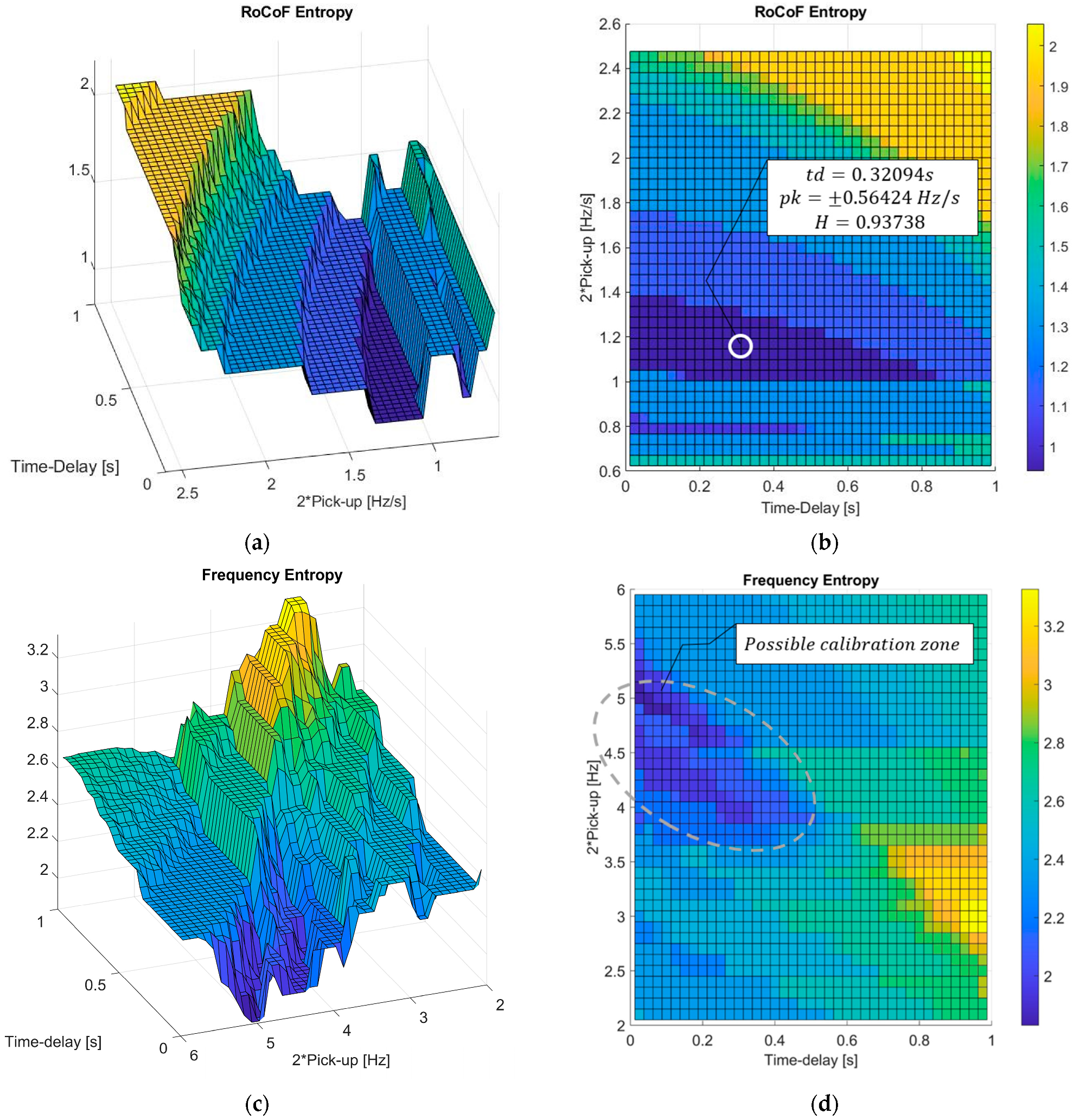


| Name | |||||||
|---|---|---|---|---|---|---|---|
| Islanding 30% | 30 | 0.15 | 0.1 | [0;0.15] | [0;0.15] | [70%;130%] | 0.85 |
| Islanding 50% | 30 | 0.15 | 0.1 | [0;0.15] | [0;0.15] | [50%;150%] | 0.85 |
| Islanding 150% | 30 | 0.15 | 0.1 | [0;0.15] | [0;0.15] | [0;150%] | 0.85 |
| Validation: (Islanding 150%) | 100 | 0.15 | 0.1 | [0;0.15] | [0;0.15] | [0;150%] | 0.85 |
| Name | Simulation Time | Events | Location | EPS Generation | |
|---|---|---|---|---|---|
| Distribution Faults | 30 | 2.5 s | 1/2/3-Ph.ShortCircuit | B1;B2;B3;LV4 LV5;LV6;LV7;LV8 | - |
| Validation Distribution Faults | 100 | 2.5 s | 1/2/3-Ph.ShortCircuit | B1;B2;B3;LV4 LV5;LV6;LV7;LV8 | - |
| EPS Disturbances | 30 | 10.5 s | G2;G3;G4 trips | - | [1; 5]% |
| Validation EPS Disturbances | 100 | 10.5 s | G2;G3;G4 trips | - | [1; 5]% |
| Work | IDM | Dataset Size | Equivalent Achievable Entropy | ||
|---|---|---|---|---|---|
| Current Work: (BEM) | RoCoF | 60 | 0.9891 | 0.9891 | 0.34602 |
| Setting Map Methodology (SMM) [47,48] | RoCoF | 4606 | 0.9781 | 0.9902 | 0.4568 |
| Pattern Recognition Approach [41] | Wavelet Decision Tree classifier | 2091 | 0.9765 | 0.9520 | 0.8752 |
| Wavelets and Deep Learning Methodology (WDLM) [42] | Wavelet Deep Learning | 2046 | 0.9891 | 0.9855 | 0.3915 |
| Reliable Islanding Detection Scheme (RIDS) [43] | Modified Intrinsic Mode Functions (MIMF) | 720 | 0.9740 | 0.9859 | 0.5672 |
Disclaimer/Publisher’s Note: The statements, opinions and data contained in all publications are solely those of the individual author(s) and contributor(s) and not of MDPI and/or the editor(s). MDPI and/or the editor(s) disclaim responsibility for any injury to people or property resulting from any ideas, methods, instructions or products referred to in the content. |
© 2024 by the authors. Licensee MDPI, Basel, Switzerland. This article is an open access article distributed under the terms and conditions of the Creative Commons Attribution (CC BY) license (https://creativecommons.org/licenses/by/4.0/).
Share and Cite
Seguin Batadi, E.M.; Martínez, M.; Molina, M.G. Bayesian Entropy Methodology: A Novel Approach to Setting Anti-Islanding Protections with Enhanced Stability and Sensibility. Energies 2024, 17, 693. https://doi.org/10.3390/en17030693
Seguin Batadi EM, Martínez M, Molina MG. Bayesian Entropy Methodology: A Novel Approach to Setting Anti-Islanding Protections with Enhanced Stability and Sensibility. Energies. 2024; 17(3):693. https://doi.org/10.3390/en17030693
Chicago/Turabian StyleSeguin Batadi, Eduardo Marcelo, Maximiliano Martínez, and Marcelo Gustavo Molina. 2024. "Bayesian Entropy Methodology: A Novel Approach to Setting Anti-Islanding Protections with Enhanced Stability and Sensibility" Energies 17, no. 3: 693. https://doi.org/10.3390/en17030693
APA StyleSeguin Batadi, E. M., Martínez, M., & Molina, M. G. (2024). Bayesian Entropy Methodology: A Novel Approach to Setting Anti-Islanding Protections with Enhanced Stability and Sensibility. Energies, 17(3), 693. https://doi.org/10.3390/en17030693








